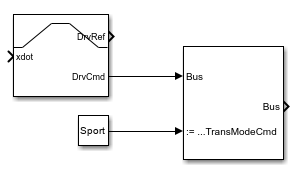Slowly Increasing Steer
Libraries:
Vehicle Dynamics Blockset /
Vehicle Scenarios /
Drive Cycle and Maneuvers
Description
The Slowly Increasing Steer block generates steering, accelerator, and brake commands to conduct a linearly increasing steering maneuver. The steering command begins at the specified rate once the vehicle reaches the longitudinal velocity setpoint. After the vehicle achieves the maximum steering angle, the vehicle maintains the steering angle for a set duration. The block then reduces the steering angle to zero at the same rate. A longitudinal controller regulates the vehicle at the prescribed speed throughout the maneuver. You have the option to stop the simulation at a lateral acceleration threshold.
The slowly increasing steer maneuver is a foundational test to help assess the vehicle's lateral dynamics and understeer characteristics. You can also use the maneuver to set up additional tests such as swept sine, sine with dwell, and fishhook.
Note
For information on the reference generator block used in the slowly increasing steer reference application, see Slowly Increasing Steer Reference Generator.
Ports
Input
Output
Parameters
Extended Capabilities
Version History
Introduced in R2024b

